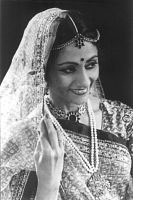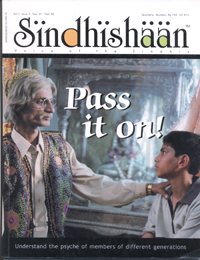THE UNFOLDING OF A DANCER – KATHAK KALA KI RANI KARNAA
By Sundar Iyer
 Rani Karnaa nurtured under many a great Guru and is now considered amongst the foremost exponents of Kathak and Odissi. She has through the years, with her dedication and devotion to her passion for dance scaled great heights, and is undoubtedly looked up as a role model and idol by many who intend to further in this medium of artistic expression. SINDHISHAAN had the opportunity to meet up with this great performer in Mumbai and spoke to her at length about the influence of dance in her life, her dance academy in Kolkatta (Calcutta), her memories of her childhood days in Sindh and her thoughts on how to keep the flame of Sindhi culture lit until eternity.
Rani Karnaa nurtured under many a great Guru and is now considered amongst the foremost exponents of Kathak and Odissi. She has through the years, with her dedication and devotion to her passion for dance scaled great heights, and is undoubtedly looked up as a role model and idol by many who intend to further in this medium of artistic expression. SINDHISHAAN had the opportunity to meet up with this great performer in Mumbai and spoke to her at length about the influence of dance in her life, her dance academy in Kolkatta (Calcutta), her memories of her childhood days in Sindh and her thoughts on how to keep the flame of Sindhi culture lit until eternity.
Born in the year 1939 in Hyderabad, Sindh, Rani Karnaa is originally from the district of Larkana. She is the daughter of Shri Assandas Karnaa and belonged to the family of Karnamalani, which later evolved into Karnani and subsequently Karnaa. Her parents migrated to Delhi in the year 1942 when she was only three years old. From her early childhood she loved to dance and her subsequent education under Dance Gurus revealed glimpses of the artistic expression, which would later crown her as the queen of kathak dance. She completed her schooling from Delhi and did her college academics in the science stream from the prestigious Hindu College. She later received her Botany Honours but discontinued her academic interests and pursued her scholarship study in dance. Since then there has been no looking back for this charismatic dancer, who has enthralled millions worldwide with her fantastic dance presentations which have in it a rare combination of artistry and creative expression at the highest aesthetic level.
Rani had learnt the classical dance forms of Kathak, Odissi, Bharatanatyam and Manipuri. She finally chose to explore herself in the dance of storytelling, Kathak. Kathak literally means to tell a story. (Katha) Kathak is a form of classical dance closely connected to Indian religion, mythology, literature and music. This traditional dance form primarily belongs to Northern and Western India but is also extensively practiced in Bengal. Rani Karnaa has been nurtured in Kathak by great gurus such as Nrityacharaya Narayan Prasad, Pandit Sunder Prasad and Birju Maharaj. Recalling her initial days under the great Birju Maharaj she says, “Birjuji was a child guru. Once his father expired he started teaching at the age of 12 and I learnt under him for 5 years.” Rani Karnaa learnt the Jaipur Gharana of Kathak dance under Guru Hiralal, while she polished her skills in the Lucknow Gharana under Birju Maharaj. She has also learnt Odissi from Pandit Kelucharan Mohapatra for nearly twenty years between 1966 and 1985.
On asked to recount her early days in Sindh, she says with an aura of innocence surrounding her, “I remember as a child we used to spend our vacations in Sindh. The weather in Sindh used to be extremely hot. My folks at home used to give us children adheles and payees if we spent the afternoon sleeping. It was all so wonderful.” She suddenly gets into a reflective mood as she recalls the horrors of partition. She says, “Though I was fortunate to not witness the gruels of partition personally, I remember those days of emotional trauma, which my relatives had endured.” She recalls, “Partition was a huge jolt for us Sindhis. It wasn’t easy for the people of the community to get back their bearings. Though physically we were not affected, my relatives, my uncles were involved in those ghastly times. My maternal uncles were compelled by the then prevailing circumstances of communal unrest to flee Sindh. They later settled in Bombay.”
Regaining composure, she further continues, “I used to hear Sufi poetry from my father. As a child I remember, he used to read the verses of the great Sufi poet Shah Abdul Latif and narrate his great couplets. She then states with a charming smile, “I have even performed to a couple of Latif’s couplet compositions, Leela-Chanesar and Umar-Maravi.” She clearly remembers, that during her visits to Bomaby to meet her uncles, she has seen Dada Ram Panjwani frequently presenting ‘Chaunki’. She says, “My cousin Parvati Karnaa got married to Nand Tolani and I have seen and witnessed Dada performing at the Tolani household at Parle in Mumbai. Dada used to perform at all celebrations and enact excerpts from folk tales. But partition took its toll on Sindhis and post-partition they were all involved in their financial resuscitation. Ever since, there has been no cohesive force involved in the promotion of Sindhi cultural activities. In a few Sindhi pockets, there are attempts at preserving the Sindhi culture, but unfortunately there are not many Sindhis devoted to music and dance.”
She herself concedes that her involvement with Sindhi culture has unfortunately been rather sporadic. Her marriage into an Oriya family and her husband’s constant transfers from one place to another too have contributed to her not being able to shower much attention to the revival of the Sindhi culture. But she readily agrees, “I will contribute more regularly to the community now.” She says that rhythmic aspects transcend language, “I will imbibe and present it in musical and dance forms for the growth of the Sindhi culture.”
During the early 60s she has performed at Rang Bhavan in Dhobi Talao in Bombay for the Sindhi Sahitya Sabha. She has also performed together with Shanti Hiranandani, one of the few disciples of Begum Akhtar. She recalls that she has even acted as ‘Sohni’ and directed an Operatic dance presentation on Sohni-Mahiwar which had music by Shri Kanh Motiha, which was performed at the prestigious Shanmukhanada Hall in Bombay and later in Delhi and other places. She has also worked with the Late Gobind Malhi. “I have even worked with Popati Dadi and have performed dance presentations on her verses.”
On being further questioned whether Sindhis are leading Sindhi lifestyle, she retorts, “The major aspect is culture. In certain specific Sindhi pockets, culture has been preserved. In other areas, Sindhis have mixed with the local cultures. Music and dance are the soul of any culture. There are a lot of lacunae in the written works, music and dance of Sindh. The same has to be aptly imbibed. More unified efforts have to spring across all quarters.” When quipped on how to keep the flame of the Sindhi culture burning, she says, “There are 2 – 3 vital elements which have to be adhered to. The Sindhi language has to be further experimented upon through music and dance. Parents must make it a custom to speak Sindhi at home at all times, so as to increase the exposure of the language to the youngsters. The Sindhi customs have to be practiced and adopted on all occasions. There also is the need for more occasions to celebrate apart from Cheti Chand and Diwali.”
Falling back to discuss on her dance career, we understand that she has contributed extensive hours researching on Dance. She has conducted a study on the comparative differences in the various dance forms. On being asked to comment on the richness and diversity of the various classical dance forms that exist in India, she says, “It is flabbergasting. Each style is so different. There have been so many regional variations evolved over the centuries. The various dance forms and their text and literature have evolved depending on the eco-social conditions and the regional language. Sanskrit is a common language between all classical Indian dance forms, though all dance forms have their own literature. The evolution of dance is fairly interesting. Manipuri from the east and Katha from north look so different. Kathak is the story, while Kathakali from the south is the unfolding of a story.” Rani Karnaa is known to have enriched and integrated the great traditions of Jaipur Gharana and Lucknow Gharana dance forms of Kathak with an unusual sense of aesthetic adventure.
Her creative repertoire finds expression in the integrated compositions of Sahitya, Sangeeta and Nritya. Based on the verses of the saint poet Surdas and Gurudev Rabindranath Tagore, her Kathak dance presentations of Navarasamalika and Anand Dhara have received wide acclaim. Her work on the aesthetics of Kathak with Professor S K Saxena is now well recognized. The Statesman once wrote, “ . . . . . .Rani Karnaa is not only one of our most graceful Kathak dancers, she is also known for having considerably enriched and beautified this system. . . . . it is doubtful whether any single person has achieved as much, in a quiet and unostentatious manner, as Rani Karnaa. . . .” Not one to be content with laurels, Rani learnt Odissi with passion under the guidance of Guru Kelucharan Mohaptra. She has contributed immensely in the rediscovery and enrichment of that ancient tradition. Her presentation of Meghadoota on Kalidas recitations in that style bears testimony to her versatility.
On being asked as to how she feels on being rated as amongst the best in her dance form and on having achieved many a glory in dance, she says, “There is yet so much to come. There are a lot of my dreams that are yet to be fulfilled. Everyday is a new learning. If you have the desire to learn more, you will know more. Art is dynamic, it is constantly changing and improving. I still have the desire of learning more and unfolding further on my own dance form.”
Much honoured, one can list the President’s Gold Medal in 1955, the order of the Queen of Laos in 1964 and Vijay Ratna in 1990. She has been nominated as a ‘Senior Fellow’ in the field of Kathak Dance by the Department of Culture, Ministry of HRD of the Government of India. She has also been honoured by the Akhil Bhartiya Sindhi Boli and Sahitya Sabha in 1998.
Such is the Queen of Kathak, Rani Karnaa (Nayak) who has also received the Sangeet Natak Akademi award for her contribution to Kathak, undoubtedly a renowned exponent of our time.


